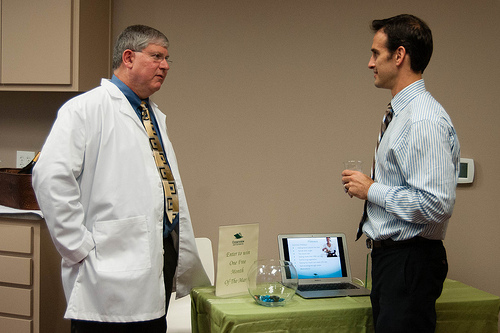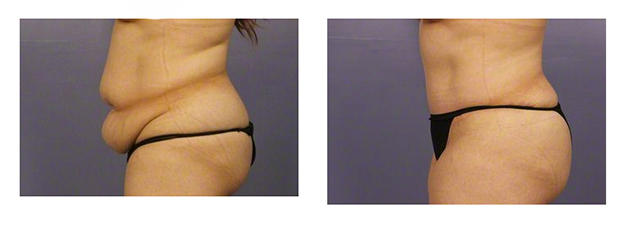 Photograph courtesy of MARINA PLASTIC SURGERY/ DR. MACIAS
Photograph courtesy of MARINA PLASTIC SURGERY/ DR. MACIAS
So I decided to look into a tummy tuck. While often considered a procedure for the rich and famous, tummy tucks (also known as abdominoplasties) are becoming increasingly common, with a whopping 431% increase in the number of procedures performed since 1997, when the American Society for Aesthetic Plastic Surgery (ASAPS) started tracking it. In fact, tummy tucks were the third most common cosmetic procedure performed in 2015, with more than 180,000 done nationwide.
Whether the pooch was caused by pregnancy, significant weight loss, or genetics, removing excess skin and tightening lax muscles can provide both physical and mental benefits. If you've been thinking about getting a tummy tuck, here are a few things I learned along the way—and a few I wish I'd known beforehand.
1. A tummy tuck won't make you drop weight.
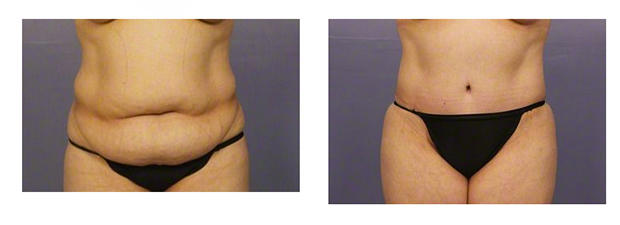 Photograph courtesy of MARINA PLASTIC SURGERY/ DR. MACIAS
Photograph courtesy of MARINA PLASTIC SURGERY/ DR. MACIAS
While some patients may lose a few pounds from the procedure, Elliot Hirsch, MD, a board-certified plastic surgeon at Hirsch Plastic Surgery in Los Angeles, warns that tummy tucks should be used when a patient is already at his or her ideal weight. "Tummy tucks should not be thought of as a weight loss procedure, but rather as a contouring procedure," he explains. Also, while tummy tucks can't directly address stretch marks, since the abdominal skin is pulled downward, any stretch marks may be moved, lowered, or potentially removed if they are part of the lower excess skin.
2. There are a few different types of scars.
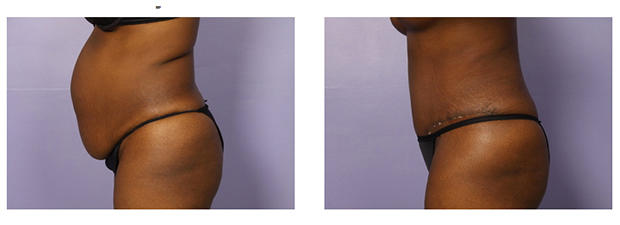 Photograph courtesy of MARINA PLASTIC SURGERY/ DR. MACIAS
Photograph courtesy of MARINA PLASTIC SURGERY/ DR. MACIAS
Your scar size and location will depend on the type of abdominoplasty you need. For a traditional tummy tuck like I had, the scar will be from hip to hip and most doctors will do their best to ensure that the scar is hidden under the bikini line. You will also have a scar around your belly button, because it's actually relocated (!) during the procedure.
For patients who need just a small amount of skin removed and muscles tightens, a mini tummy tuck may be an option. "A mini tummy tuck is one in which there is a very little amount of skin excess, usually below the belly button, and the incision leaves a scar a little longer than a C-section scar," explains Luis Macias, MD, a double board-certified plastic surgeon at Marina Plastic Surgery in Marina Del Rey, CA.
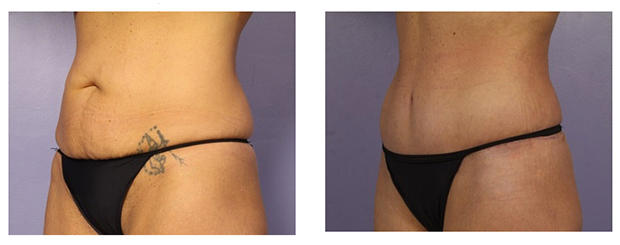 Photograph courtesy of MARINA PLASTIC SURGERY/ DR. MACIAS
Photograph courtesy of MARINA PLASTIC SURGERY/ DR. MACIAS
Patients who are interested in a tummy tuck after significant weight loss or weight loss surgery can expect a large, upside-down T-shaped scar across the abdomen. That's because in these types of patients, "there is horizontal skin excess as well as vertical—it extends up the midline of the abdomen," says Macias.
3. It isn't cheap, and insurance likely won't cover it.
According to the ASAPS Cosmetic Surgery National Data Bank statistics, the 2015 national average was $5,891. Typically, a tummy tuck is considered a cosmetic procedure and is not covered by insurance. If you are having a hernia repaired or if the surgery solves another medical problem (such excess skin from massive weight loss), some insurances may (key word: may) cover a small portion of the procedure. And beyond the cost of the surgery itself, you'll also need to be prepared to spend money on prescriptions and other pre-op and post-op medical supplies.
4. It's important to do your research before choosing a surgeon.
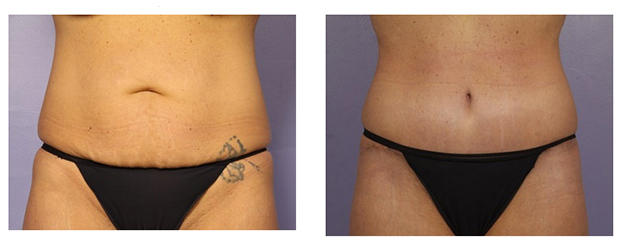 Photograph courtesy of MARINA PLASTIC SURGERY/ DR. MACIAS
Photograph courtesy of MARINA PLASTIC SURGERY/ DR. MACIAS
Finding a qualified plastic surgeon can be trickier than you'd think. First, while the terms are often used interchangeably, a plastic surgeon and a cosmetic surgeon are not the same thing. Likewise, a doctor may claim to be "board-certified" by a board that isn't recognized by the American Board of Medical Specialties (ABMS), a recognized agency approving medical specialty boards since 1934. The ABMS recognizes only one plastic surgery board—the American Board of Plastic Surgery (ABPS). Here's why this all matters: Legally, any licensed physician can offer "cosmetic" procedures. The doctor might be a dermatologist or gynecologist or a general practitioner, but since there is no nationally recognized cosmetic surgery medical board, any doctor could claim to be a cosmetic surgeon. Many likely have gone through some training, and some may be very capable surgeons, but if they are not certified by the ABPS, they are not plastic surgeons. In addition, some surgeons are also certified by the American Board of Surgery, making them dual board-certified. Doctors may also be members of other plastic surgery–related associations, academies, or societies, but these memberships should be secondary to ensuring they are ABPS-certified.
5. Don't freak out if your surgeon recommends liposuction, too.
Mine did, and it was more than just an upsell. "I perform liposuction on most of my tummy tuck patients because it assists in sculpting the waist and love handle area," explains Macias. When skin from the upper abdomen gets pulled down, it can lead to an unnatural bulge on the hips or a lack of definition. In order to get the best results, many surgeons use liposuction or fat-to-fat grafts to help them reshape and contour the area. However, liposuction is a separate procedure from the tummy tuck, which means it will have its own added cost, risks, and recovery factors.
6. You'll need help at home for the first week.
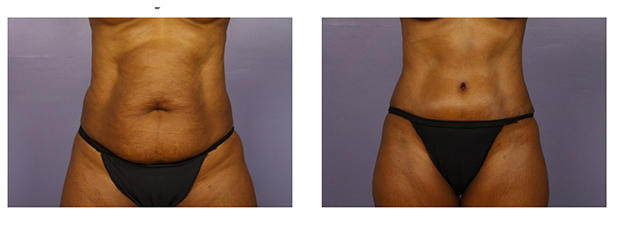 Photograph courtesy of MARINA PLASTIC SURGERY/ DR. MACIAS
Photograph courtesy of MARINA PLASTIC SURGERY/ DR. MACIAS
Most tummy tucks are outpatient surgeries, which means you'll go home right after the procedure and will need to have someone there to help you for the first few days, if not a full week. "I would not have felt comfortable home alone," says Crystal M., a 51-year-old mother of two and tummy tuck patient who helped prepare for her recovery by stocking her kitchen with pre-cut fruit and other comfort foods. "I needed someone to help me do everything for the first few days," recalls Erin S., a 37-year-old mom of three who had the procedure. "I could not roll over, sit up, or grab anything farther than a few inches away. I needed help standing, getting repositioned in bed, basically everything." In addition, doctors recommend that you don't lift anything over 10 pounds for the first 4 to 6 weeks, which can be important for mothers with young children to consider.
7. You'll likely be bent over at the waist for the first few days (or longer).
One result of your stomach muscles being tightened, excess skin removed, and remaining skin pulled taut is that you'll probably be significantly bent over for the first few days—or even weeks. I looked like the letter L for a solid 2 weeks. Being bent over like this for so long had a couple of consequences that I wish I had been better prepared for. First, my lower back muscles pretty much gave up on day 3, and I had immense pain and back spasms whenever I walked or stood (Icy Hot and Bengay were life-savers). Second, I couldn't reach anything that was above my new eye level. This meant that I couldn't get anything from the top two shelves of my fridge. Jedi mind tricks were not enough to bring me any closer to that container of dark chocolate–covered almonds taunting me from the top shelf.
This bent-over position also impacts how you sleep. You should plan on sleeping in a recliner, with a wedge pillow, or on a couch with a bunch of pillows to prop up your legs and back until you're able to lie flat, around week 2.
8. Expect benefits beyond the cosmetic.
True, you'll likely feel a lot more confident in your clothes after a tummy tuck, like Crystal did. Before the tummy tuck, she says that she had chosen outfits to accommodate her stomach. "Now I can pick out clothes that I like and know I look great in them." However, the procedure can also offer medical benefits: Some studies have suggested that tummy tucks may help with urinary incontinence, and the procedure can have a big impact on the strength and support of your body's core. "An integral part of a tummy tuck is repairing the rectus diastasis, which is a space between the rectus muscles that naturally occurs after childbirth or a large amount of weight loss," explain Hirsch. "For patients with a significant diastasis, repairing this can help improve their core stability and can also help with back pain and bloating." This is something Erin found to be true after her abdominoplasty. "Now when I go to the gym and do ab work, I can actually feel my core engaging," she says. "Prior to surgery, I never felt anything happening in my abs."
For me, I'll admit that the first 2 weeks were a physical and emotional roller coaster, but now, 5 weeks out, I'm already enjoying the benefits of my clothes fitting better and feeling more confident, and I'm looking forward to rediscovering my newly tightened abs. Oh, and finally reaching those dark chocolate–covered almonds.

